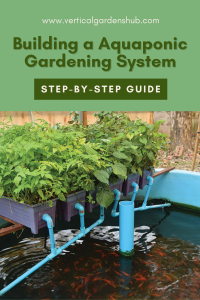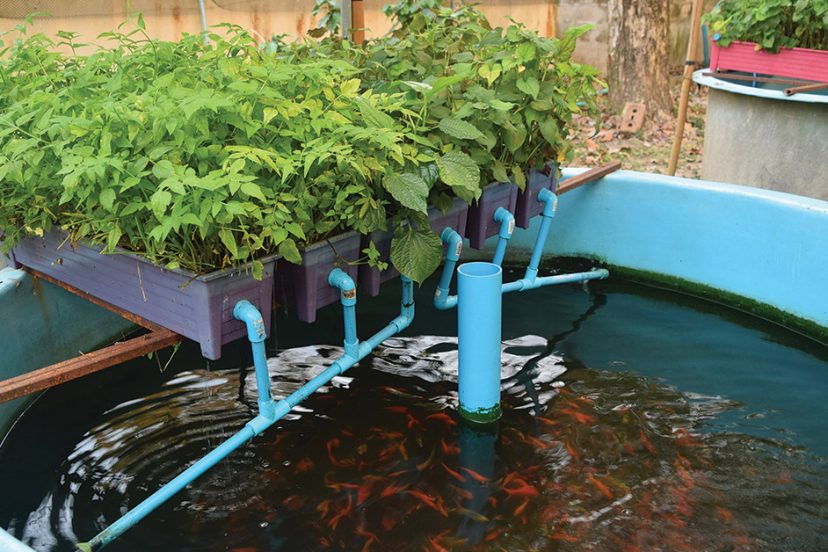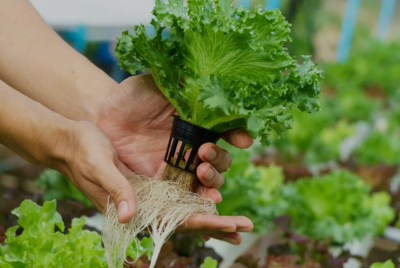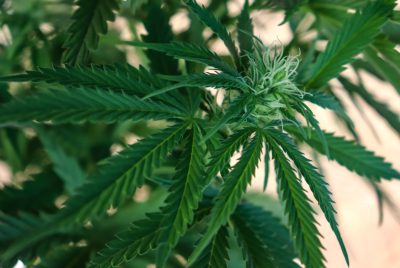Build an Aquaponic Gardening System
Aquaponic gardening is an innovative and sustainable approach that combines aquaculture and hydroponics in a symbiotic relationship. With a DIY aquaponic system, you can create a sustainable and fascinating garden where plants and fish work together in harmony. If you’re new to aquaponics and want to learn how to build your own system, you’ve come to the right place. This step-by-step guide will walk you through the entire process, from planning and setup to maintenance and troubleshooting.
In this Article:
- What is Aquaponic Gardening?
- Understanding the Symbiotic Relationship
- Why Choose Aquaponics?
- Planning your Aquaponic System
- Building the Fish Tank
- Constructing the Grow Bed
- Plumbing and Water Circulations
- Cycling the System
- Introducing Fish and Plants
- Maintaining you Aquaponic System
- Troubleshooting Common Issues
- The Benefits of Aquaponics
- Tips for Maximizing your Aquaponic System
- Incorporating Aquaponics into Vertical Gardens
What is Aquaponic Gardening?
Aquaponic gardening is a unique and sustainable way of growing plants and raising fish together in a closed-loop system. It’s like having a mini ecosystem in your garden! In this system, fish live in a tank, and their waste is converted into nutrients by helpful bacteria. These nutrients are then used by plants to grow, and the plants, in turn, purify the water for the fish. It’s a win-win situation for both, and you get fresh vegetables and fish as a result!
Understanding the Symbiotic Relationship
The real magic of aquaponic gardening lies in the symbiotic relationship between fish and plants. The fish produce waste that contains ammonia. Beneficial bacteria convert this ammonia into nitrites and then into nitrates, which serve as essential nutrients for the plants. As the plants take up these nutrients, they naturally filter the water, providing a clean and healthy environment for the fish to live in.
Why Choose Aquaponics?
Aquaponics offers several advantages that make it a fantastic choice for gardening:
- Water Efficiency: Aquaponics uses significantly less water compared to traditional gardening methods, making it environmentally friendly.
- Organic Produce: Since no chemicals or pesticides are used, the produce from an aquaponic system is organic and safe to eat.
- Educational and Therapeutic: Aquaponics provides a hands-on and educational experience, making it a fun activity for families and schools. It also offers therapeutic benefits, reducing stress and promoting well-being.
Also read:
- Aquaponic Gardening: A Symbiotic Relationship
- Hydroponics vs Aeroponic Gardens: How they differ
- Vertical Hydroponic Gardening: How, Why and Types
- Aeroponic Gardening for Beginners: Understanding the Basics
Planning Your Aquaponic System
Before you start building, it’s essential to plan your aquaponic system properly.
- Selecting the Right Location: Choose a sunny spot in your garden where the system will receive ample sunlight. It should also be a place that’s easily accessible for maintenance and care.
- Choosing the System Size: The size of your aquaponic system will depend on the available space and your needs. Consider how many fish you want to raise and the types of plants you’d like to grow.
- Deciding on Fish and Plants: Select fish species that are suitable for aquaponics and can thrive in the conditions you can provide. For beginners, common choices include tilapia, trout, and catfish. As for plants, choose ones that do well in hydroponic systems, such as lettuce, herbs, and tomatoes.
Building the Fish Tank
The fish tank is the heart of your aquaponic system, so take your time with the construction.
- Material Selection: Choose food-safe materials like fiberglass, food-grade plastic, or galvanized metal for the tank. Avoid using materials that may release harmful substances into the water.
- Tank Size and Shape: The size and shape of the tank will depend on the available space and the number of fish you plan to keep. Make sure it’s large enough to accommodate your fish comfortably.
- Adding Filtration System: Incorporate a reliable filtration system to remove solid waste from the water. This helps maintain water quality and keeps your fish healthy.
Constructing the Grow Bed
The grow bed is where your plants will flourish, so it’s essential to set it up correctly.
- Grow Bed Materials: Use suitable materials like gravel, expanded clay pellets, or rafts to support the plant roots. These materials also provide space for beneficial bacteria to grow.
- Size and Depth: The size and depth of the grow bed are crucial for the root development of your plants. Ensure there’s enough space for the plants to grow and spread their roots.
- Adding Grow Media: Introduce your chosen grow media to the bed. Before using it, rinse the media thoroughly to remove any dust or debris. The media will provide support for your plants and help retain moisture.
Plumbing and Water Circulation
Proper plumbing and water circulation are vital for the success of your aquaponic system.
- Connecting the Tank and Grow Bed: Set up a pump and pipes to allow water to flow from the fish tank to the grow bed. This cycle ensures that nutrients from the fish tank reach the plants.
- Ensuring Proper Water Flow: Adjust the flow rate to ensure that the water reaches all parts of the grow bed evenly. This ensures that your plants receive enough nutrients and oxygen.
Cycling the System
Before adding fish and plants, you need to cycle your aquaponic system.
- Introduction to Nitrogen Cycle: Understand the nitrogen cycle, which is the process that converts fish waste into nutrients for your plants. The cycle involves beneficial bacteria breaking down ammonia into nitrites and then into nitrates.
- Seeding Beneficial Bacteria: Introduce beneficial bacteria to your system to kickstart the nitrogen cycle. These bacteria are essential for establishing a stable environment for your fish and plants.
Introducing Fish and Plants
With your system cycled and ready, it’s time to introduce the stars of the show – fish and plants!
- Acclimating Fish to the System: Gradually introduce your fish to their new home to minimize stress. Monitor their behavior to ensure they adapt well.
- Transplanting Seedlings: Gently transplant your seedlings into the grow bed. Be careful not to damage their roots during the process.
Maintaining Your Aquaponic Gardening System
Congratulations! Your aquaponic gardening system is now up and running. To keep it flourishing, you’ll need to maintain it properly.
- Monitoring Water Parameters: Regularly test the water parameters like pH, ammonia, nitrite, and nitrate levels. This will help you maintain a healthy environment for both your fish and plants.
- Feeding and Caring for Fish: Feed your fish the appropriate diet and ensure they have a clean and stress-free environment. Healthy fish mean healthy plants!
- Pruning and Harvesting Plants: As your plants grow, they may need pruning to promote healthy growth. Regularly harvest the produce and enjoy the fruits of your labor!
Troubleshooting Common Issues
Like any gardening endeavor, aquaponics may come with some challenges. Here are a few common issues you might encounter and how to address them:
- Algae Blooms: If you notice excessive algae growth, reduce sunlight exposure to the water and consider adding algae-eating fish.
- pH Imbalance: To address pH imbalances, add pH stabilizers or adjust the fish feeding frequency.
- Fish Health Problems: If your fish show signs of illness, quarantine affected individuals and seek advice from an aquatic veterinarian or experienced aquaponics enthusiast.
The Benefits of Aquaponic Gardening
Your aquaponic gardening system offers numerous benefits that make it a rewarding and sustainable choice:
- Sustainability and Water Efficiency: By recycling water and nutrients, aquaponics reduces water usage and promotes eco-friendly gardening.
- Organic and Chemical-Free Produce: Enjoy fresh, organic, and pesticide-free produce right from your garden.
- Educational and Therapeutic Value: Aquaponics provides an excellent learning opportunity for kids and a therapeutic escape for gardeners.
Tips for Maximizing Your Aquaponic Gardening System
To get the most out of your aquaponic gardening system, consider these helpful tips:
- Balance Fish and Plant Ratio: Ensure you have the right balance of fish and plants in your system to maintain a healthy environment.
- Introduce Companion Planting: Grow companion plants that support each other’s growth and health.
- Experiment and Learn from Mistakes: Don’t be afraid to try new things and learn from any challenges you may face. Every garden is a unique journey!
Incorporating Aquaponics into Vertical Gardens
If space is limited, consider integrating aquaponics into a vertical gardening setup.
- Utilizing Vertical Space: Vertical gardens maximize growing area, making them perfect for small yards or balconies.
- Adding Aesthetics to the Setup: Create a visually pleasing aquaponic display by incorporating artistic designs and decorations.
Conclusion
Congratulations on completing your aquaponic gardening journey! You’ve built a remarkable ecosystem where fish and plants work together to create a sustainable and productive garden. With a little love, care, and patience, your aquaponic system will continue to provide you with fresh vegetables and the joy of nurturing aquatic life. Enjoy the beauty and abundance of your very own DIY aquaponic garden!

FAQs
Q: How much time do I need to invest in maintaining an aquaponic system?
Maintaining an aquaponic system requires regular attention, but once established, it’s relatively low maintenance. You’ll need to monitor water parameters and tend to the plants and fish, which may take around 1-2 hours per week.
Q: Can I use any type of fish in my aquaponic system?
While you can use various fish species, it’s essential to choose ones that thrive in the specific conditions of your system. Tilapia, trout, and catfish are popular choices for beginners.
Q: Is it possible to grow fruiting plants like tomatoes in an aquaponic system?
Absolutely! Fruiting plants like tomatoes, cucumbers, and peppers can grow exceptionally well in aquaponics, provided they receive adequate nutrients and support.
Q: What can I do with excess fish waste in the system?
Excess fish waste can be used as nutrient-rich fertilizer for other outdoor plants or even composted for traditional soil gardening.
Q: Can I integrate aquaponics with my existing garden?
Yes, you can! Aquaponics can be integrated into existing gardens, either as a standalone system or by using grow beds to supplement traditional gardening methods.





